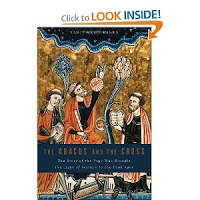Over at Religion Dispatches Quarterly there is an absolutely riveting review of a new book by Nancie Marie Brown, entitled The Abacus and the Cross: The Story of the Pope Who Brought the Light of Science to the Dark Ages. I can’t wait to read the book now, but the review itself is quite interesting in and of itself. Some highlights:
A professor at a cathedral school for most of his career, Gerbert of Aurillac was the first Christian known to teach math using the nine Arabic numerals and zero. He devised an abacus, or counting board, that mimics the algorithms we use today for adding, subtracting, multiplying, and dividing. It has been called the first counting device in Europe to function digitally—even the first computer. In a chronology of computer history, Gerbert’s abacus is one of only four innovations mentioned between 3000 B.C. and the invention of the slide rule in 1622.
In the caliph’s library in Cordoba were at least 40,000 books (some said as many 400,000); Gerbert’s French monastery owned less than 400. Many of the caliph’s books came from Baghdad, known for its House of Wisdom, where for 200 years works of mathematics, astronomy, physics, and medicine had been translated from Greek and Persian and Hindu and further developed by Islamic scholars under their caliph’s patronage. In the world Gerbert knew, Arabic was the language of science.
Juste relaxed. He began flipping through the pages, pointing to letters, running his finger along a line, thumbing pages back and forth—for all the hoopla, he didn’t treat “the earliest proof of the transmission of Arabic science to the West” as a sacred object. It was a book.
Even the most mystical of the chroniclers of the time, Ralph the Bald, the one who recorded all the signs and wonders presaging the Apocalypse and attributed every act and event to the will of God—even Ralph knew the earth was round. Describing the imperial insignia, he said it was “made in the form of a golden apple set around in a square with all the most precious jewels and surmounted by a golden cross. So it was like this bulky earth, which is reputed to be shaped like a globe.”
I love the idea that certain centers of learning are so famed and wide-spread that scholars flock to them, regardless of faith or politics. I imagine the royal libraries at Niole Dra or Rauxes, or even Rel Mord, might make similar claims to fame. I might even highlight the idea of scholars as pilgrims, alongside purely religious devotees. “Whither are you bound, sir?” “Why, the royal library at Nile Dra. My companions and I are hoping to consult some rare tomes for a new work of our own on the creation of mountain ranges.”
And speaking of tomes, it could very well add some color to say that such-and-such a book originated in the Imperial Library at Rauxes, and that one is a rare example of the annotated edition published at Irongate.
I’m also very intrigued by the author’s next work, briefly touched on at the end of the review. Being very familiar with the work of Snorri Sturluson, and his influence on Tolkein, it looks like I’ll have another book to add to the wish list.
And yet the ideas that make Tolkien popular—the ideas picked up by his imitators—are not all original. Many are the work of Snorri Sturluson. Without Snorri, modern fantasies would include no tall, beautiful, immortal elves; no evil dark elves or orcs; no dwarves making weapons in their halls of stone; no peaceful farmers who metamorphose at night into bears; no giant eagles who carry men about or people who fly when they don a feather cloak; no riddling dragons; no wandering wizards who talk to birds. The millions of readers and gamers worldwide who enjoy these fantasy elements have no idea they owe a debt of gratitude to medieval Iceland. They have no idea who Snorri Sturluson is. It’s time they learned.










This sounds like it belongs on my bookshelf. Thanks for the reco.
Gerbert of Aurillac was the same Pope Sylvester, IIRC, that would later be remembered as a sorcerer due to all that book learning. In my current campaign one of the foremost wizards in Wessex owes much of his power to possession of the Pope's Spellbook.
Very interesting post. I'll be looking for more of Snorri's works too.
Hmm, Snorri = Snurre of the Fire Giants?
See, another reason why Gygax stated Tolkien had no influence on D&D. He knew it was Snorri!
Ciao!
If you dont want to do alot of reading
THEN
Ken Follett's
"The Pillars of the Earth"
eight part mini-series is educational
and a feast for the eyes
GW: Well, Snorri/Snurre is a common enough Norse name. I'm guessing Gygax used it because he liked Norse names for his fire and frost giants, not for any specific association with Snorri Sturluson…
Books like this one are the reason I've been defiting away from fantasy and more and more towards proper historical stuff: there's no world, wilder, more vibrant, and more creative than the one we live in!
On a similar note, I highly recommend Régine Pernoud's Those Terrible Middle Ages: Debunking the Myths. While the given English title is a bit sensationalistic and the book can occasionally read like a pamphlet, it is an insightful look into how the commonly held image of the Middle Ages, especially the Dark Ages period, is a later construct from the Renaissance and the Romantic period. Link: http://www.amazon.com/Those-Terrible-Middle-Ages-Debunking/dp/0898707811
Also, Gerbert of Aurillac was not just pope Sylvester, but he also gave the crown to Hungary's first christian king. Quite the man.
Another very interesting book, it is a must read for anyone interested in history and science and history of science 🙂
is Lucio Russo "The forgotten revolution"
http://www.amazon.com/Forgotten-Revolution-Science-Born-Reborn/dp/3540203966/ref=ntt_at_ep_dpi_1